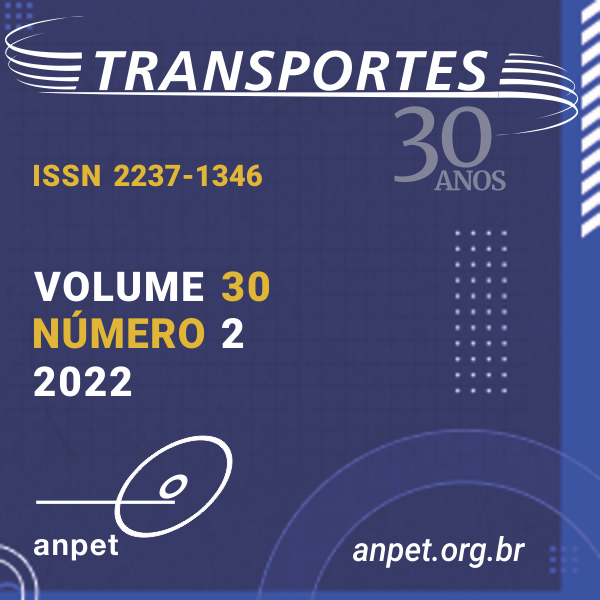Desenvolvimento de um índice de condição de pavimento flexível para rede de via urbana
DOI:
https://doi.org/10.14295/transportes.v30i2.2553Palavras-chave:
Índice de condição de pavimentos urbanos, Defeitos, ServentiaResumo
Na gerência de pavimentos urbanos é primordial desenvolver índices de condição de pavimentos para dar suporte à Secretaria Municipal de Infraestrutura durante às tomadas de decisão sobre manutenção e reabilitação (M&R). O objetivo foi desenvolver um índice de condição de pavimentos urbanos (ICPU) para pavimentos flexíveis e realizar uma análise comparativa com vários índices de condição de pavimentos (ICP). O método de trabalho consistiu em: definição do tamanho da amostra; criação de um grupo para avaliação e treinamento; coleta dados sobre o Valor de Serventia Atual (VSA) e defeitos dos pavimentos flexíveis; desenvolvimento de um ICPU; e, análise comparativa com vários ICP. O ICPU foi obtido por regressão linear múltipla com os defeitos e o VSA, em conformidade com várias análises estatísticas (testes de homoscedasticdade, correlação serial, multicolinearidade e normalidade). Os ICPs escolhidos resultaram em variabialidade entre eles e o VSA, que foi estatisticamente analisada por testes de erros e de correlação. Por fim, o ICPU proposto pode permitir melhor planejamento de M&R, distribuição de recursos e pavimentos bem mantidos, com conforto, redução do tempo de viagem e segurança.
Downloads
Referências
Albuquerque, T. P. (2017) Condition Index based on distresses for urban pavement management. Dissertation (Master of Science), in Portuguese. Federal University of Paraiba. João Pessoa, Brazil. Avaliable at: https://repositorio.ufpb.br/jspui/handle/123456789/12835 (Accessed 21 July 2021).
Arevalo, E.M.; J. L. Fernandes Jr. and S. Becker (2017) Development of a Pavement Condition Index for urban management systems. Proceedings of the World Conference on Pavement and Asset Management, WCPAM, Baveno, Italy.
ASTM (2018) ASTM D6433-18: Standard practice for roads and parking lots pavement condition index surveys. American Society of Testing and Materials, West Conshohocken, PA.
Bektas, F.; O. Smadi and I. Nlenanya (2015) Pavement Condition New Approach for Iowa Department of Transportation. Transportation Research Record, 2523, pp. 40-46. DOI: 10.3141/2523-05. DOI: https://doi.org/10.3141/2523-05
Carey, W. N. and P. E. Irick (1960) The Pavement Serviceability. Performance Concept. Highway. Research Board Bulletin, 250, p. 40-58.
Ceylan, H.; K. Gopalakrishnan; S. Kim; C. Schwartz, and R. Li (2013) Global sensitivity analysis of jointed plain concrete pavement mechanistic-empirical performance predictions. Transportation Research Record, 2367, p. 113–122. DOI: 10.3141/2367-12. DOI: https://doi.org/10.3141/2367-12
Chamorro, A.; S.Tighe; L. Ningyuan and T. Kazmierowski (2010) Validation and implementation of Ontario, Canada, network level distress guidelines and condition rating. Transportation Research Record, 2153, p. 49-57. DOI: 10.3141/2153-06. DOI: https://doi.org/10.3141/2153-06
Chatterjee, S. and A. S. Hadi (2012) Regression Analysis by Example (5th Ed.). John Wiley & Sons, Inc. New Jersey.
Chernick M. R.; H. F. Robert (2003) Introductory Biostatistics For The Health Sciences: Modern Applications Including Bootstrap. Hoboken, N.J. : Wiley-Interscience.
Chou, Y. J. and Y. Zou (2002) Determination of Test Spacing in Pavement Evaluation. Transportation Research Record, 1806(1), p. 110-117. DOI: 10.3141/1806-13. DOI: https://doi.org/10.3141/1806-13
Darlington, R. B. and A. F. Hayes (2017) Regression Analysis and Linear Models - Concepts, Applications, and Implementation. The Guilford Press, New York.
DNIT (2003a) DNIT 006 – PRO: Objective evaluation for surface of flexible and semi rigid pavements. Procedure (in Portuguese). National Department of Transport Infrastructure. Rio de Janeiro.
DNIT (2003b) DNIT 009 – PRO: Subjective evaluation for surface of flexible and semi rigid pavements. Procedure (in Portuguese). National Department of Transport Infrastructure. Rio de Janeiro.
Elhadidy, A. A.; S. M. El-Badawy and E. E. Elbeltagi (2021) A simplified pavement condition index regression model for pavement evaluation. International Journal of Pavement Engineering, n. 22, v. 5, p. 643-652. DOI: 10.1080/10298436.2019.1633579. DOI: https://doi.org/10.1080/10298436.2019.1633579
FHWA (2003) Distress Identification Manual for the Long-Term Pavement Performance Program. Publication N° FHWA-RD-03-031. Federal Highway Administration, Department of Transportation.
FHWA (2017) Pavement Performance Measures and Forecasting and the Effects of Maintenance and Rehabilitation Strategy on Treatment Effectiveness (Revised). Publication N° FHWA-HRT-17-095. Federal Highway Administration, Department of Transportation.
Fuentes, L.; R. Camargo; J. Arellana; C. Velosa and G. Martinez (2021) Modelling pavement serviceability of urban roads using deterministic and probabilistic approaches. International Journal of Pavement Engineering, 22(1), p. 77-86. DOI: 10.1080/10298436.2019.1577422. DOI: https://doi.org/10.1080/10298436.2019.1577422
Gharaibeh, N. G.; Y. Zou and S. Saliminejad (2010) Assessing the Agreement among Pavement Condition Indexes. Journal of Transportation Engineering, 136(8), p. 765-772. DOI: 10.1061/(ASCE)TE.1943-5436.0000141. DOI: https://doi.org/10.1061/(ASCE)TE.1943-5436.0000141
Haas, R., W. R. Hudson and J. P. Zaniewski (1994) Modern Pavement Management. Krieger Publising, Malamar, Fla.
Hair, J. F.; R. E. Anderson; R. L. Tatham et al. (2009) Análise Multivariada de Dados. 6. ed. Porto Alegre: Bookman.
Hamed M.; P. Jin; Y. Adu-Gyamfi; and W. G. Buttlar (2020) Pavement Image Datasets: New Benchmark Dataset to Classify and Densify Pavement Distresses. Transportation Research Record, 2674(2), p. 1–12. DOI: 10.1177/0361198120907283. DOI: https://doi.org/10.1177/0361198120907283
Kim, S.; H. Ceylan and G. Kasthurirangan (2011) Effect of M-E design guide inputs on flexible pavement performance predictions. Road Materials and Pavement Design, 8(3), 22 p. 375–397. DOI: 10.1080/14680629.2007.9690080. DOI: https://doi.org/10.1080/14680629.2007.9690080
Loprencipe, G. and A. Pantuso (2017) A Specified Procedure for Distress Identification and Assessment for Urban Road Surfaces Based on PCI. Coatings, v. 7(65), pp. 1-26. DOI: 10.3390/coatings7050065. DOI: https://doi.org/10.3390/coatings7050065
Magalhães, L. M.; F. H. L. Oliveira (2020) Identificação de condições funcionais em pavimentos urbanos auxiliada por machine learning. In: XXXIV Congresso de Pesquisa e Ensino em Transportes, [online], 16 a 21 nov., p. 1070-1080.
Mourad, M., J. L. Bertrand-Krajewski and G. Chebbo (2005) Calibration and validation of multiple regression models for stormwater quality predictions: data partitioning, effect of dataset size and characteristic. Water Science and Technology, v. 52(3), p. 45–52. DOI:10.2166/wst.2005.0060. DOI: https://doi.org/10.2166/wst.2005.0060
ODOT (2006) Pavement Condition Rating System. Ohio Departament Transportation, Office of Pavement Engineering, Ohio.
Osorio, A.; A. Chamorro; S. Tighe and C. Videla (2014) Calibration and Validation of Condition Indicator for Managing Urban Pavement Networks. Transportation Research Record, 2455, p. 28-36. DOI: 10.3141/2455-04. DOI: https://doi.org/10.3141/2455-04
Picado, S. L. et al. (2004) The pavement management system for Lisbon. In: Proceedings of the Institution of Civil Engineers, Municipal Engineer, 157, (3), pp. 157–165. DOI: 10.1680/muen.2004.157.3.157 (Accessed: 03 Mar 2016). DOI: https://doi.org/10.1680/muen.2004.157.3.157
Reza, F.; K. Boriboonsomsin and S. Bazlamit (2006). Development of a Pavement Quality Index for the State of Ohio. Proceedings. In: 85th Annual Meeting of the Transportation Research Board. National Research Council, National Academy of Sciences. Washington.
Sadeghi, J. E.; R. Najafabadi and M. E. Kaboli (2017) Development of degradation model for urban asphalt pavement. International Journal of Pavement Engineering, 18(8), p. 659-667. DOI: 10.1080/10298436.2015.1095912. DOI: https://doi.org/10.1080/10298436.2015.1095912
Schwartz, C. W.; R. Li; H. Ceylan; K. Gopalakrishnan and S. Kim (2013) Global sensitivity analysis of mechanistic-empirical performance predictions for flexible pavements. Transportation Research Record, 2368, pp. 12–23. DOI: 10.3141/2368-02. DOI: https://doi.org/10.3141/2368-02
Shah, U. Y.; S. S. Jain; D. Tiwari and M. K. Jain (2013) Development of Overall Pavement Condition Index for Urban Road Network. Procedia - Social and Behavioral Sciences, 104, p. 332 – 341. DOI: 10.1016/j.sbspro.2013.11.126. DOI: https://doi.org/10.1016/j.sbspro.2013.11.126
Vallejo, P. M. (2012) Tamaño Necesario de la Muestra: ¿Cuántos Sujetos Necesitamos? Universidad Pontificia Comillas, Facultad de Humanidades. Madrid. http://data.evalua.cdmx.gob.mx/docs/gral/taller2015/S0202EAC.pdf (Accessed: 23 March 2021).
Weixing W.; W. Mengfei; L. Hongxia et al. (2019). Pavement crack image acquisition methods and crack extraction algorithms: A review. Journal of Traffic and Transportation Engineering. 6(6), p. 535-556. DOI: 10.1016/j.jtte.2019.10.001. DOI: https://doi.org/10.1016/j.jtte.2019.10.001
Downloads
Publicado
Como Citar
Edição
Seção
Licença
Copyright (c) 2022 Tairone Paz e Albuquerque, Ricardo Almeida de Melo, Lucas Matheus Bezerra de Morais, Lucas Quintino Lira Oliveira, Azamor Cirne de Azevedo Filho

Este trabalho está licenciado sob uma licença Creative Commons Attribution 4.0 International License.
Ao submeter um manuscrito para publicação neste periódico, todos os seus autores concordam, antecipada e irrestritamente, com os seguintes termos:
- Os autores mantém os direitos autorais e concedem à Transportes o direito de primeira publicação do manuscrito, sem nenhum ônus financeiro, e abrem mão de qualquer outra remuneração pela sua publicação pela ANPET.
- Ao ser publicado pela Transportes, o manuscrito fica automaticamente licenciado sob a Licença Creative Commons CC BY 4.0. Esta licença permite o seu compartilhamento com reconhecimento da autoria e da publicação inicial neste periódico.
- Os autores têm autorização para assumir contratos adicionais separadamente, para distribuição não exclusiva da versão do trabalho publicada neste periódico (por ex.: publicar em repositório institucional ou como capítulo de livro), com reconhecimento da publicação inicial na Transportes, desde que tal contrato não implique num endosso do conteúdo do manuscrito ou do novo veículo pela ANPET.
- Os autores têm permissão e são estimulados a publicar e distribuir seu manuscrito online (por ex.: em repositórios institucionais ou na sua página pessoal) depois de concluído o processo editorial. Como a Transportes é de acesso livre, os autores são estimulados a usar links para o DOI do artigo nesses casos.
- Os autores garantem ter obtido a devida autorização dos seus empregadores para a transferência dos direitos nos termos deste acordo, caso esses empregadores possuam algum direito autoral sobre o manuscrito. Além disso, os autores assumem toda e qualquer responsabilidade sobre possíveis infrações ao direito autoral desses empregadores, isentando a ANPET e a Transportes de toda e qualquer responsabilidade neste sentido.
- Os autores assumem toda responsabilidade sobre o conteúdo do manuscrito, incluindo as devidas e necessárias autorizações para divulgação de dados coletados e resultados obtidos, isentando a ANPET e a Transportes de toda e qualquer responsabilidade neste sentido.









